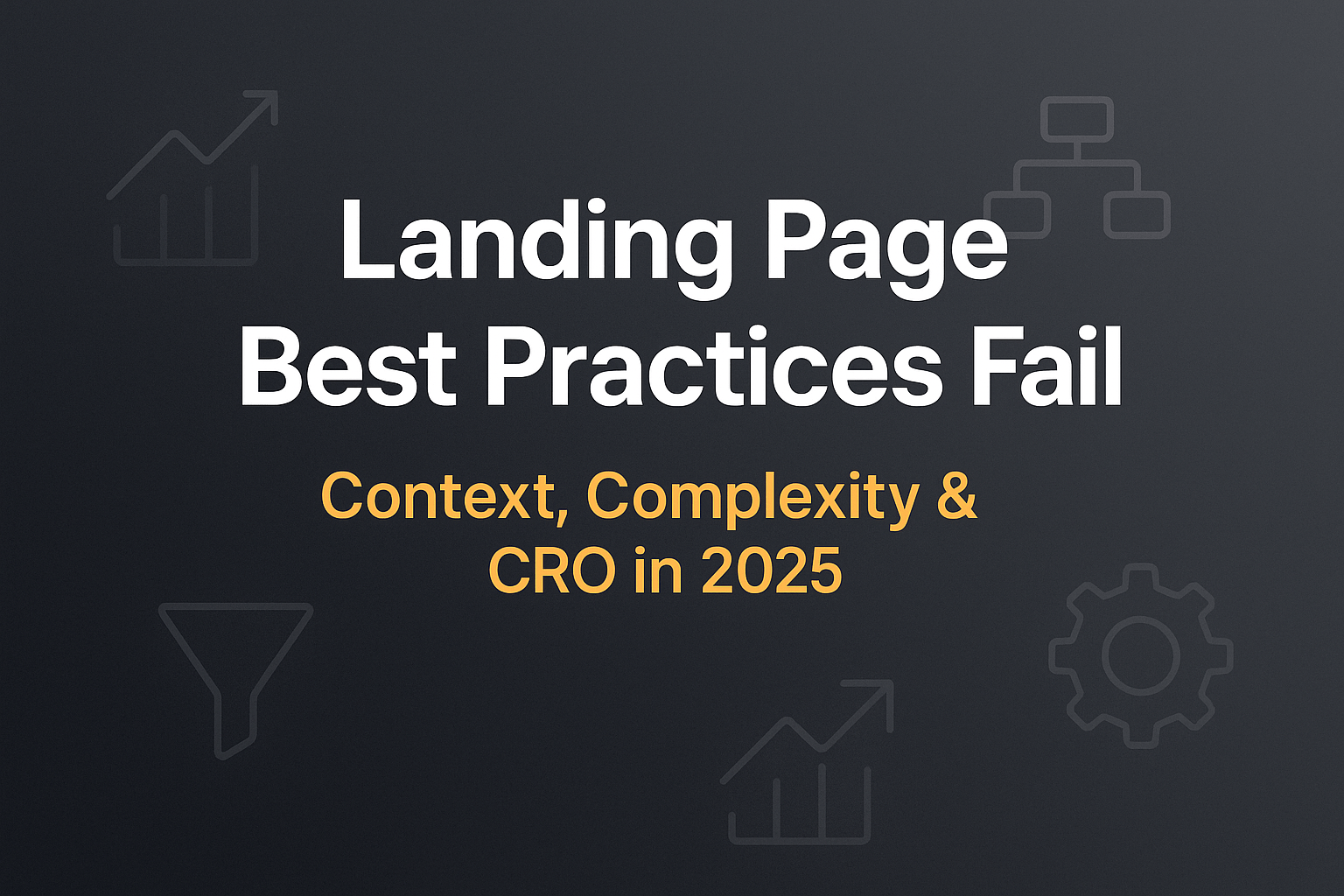For years, conversion rate optimisation (CRO) guides have preached the same landing page best practices: keep CTAs above the fold, cut form fields, add urgency. Yet in 2025, these cookie-cutter tactics rarely move the needle.
Why? Because the digital environment is fragmented, customer journeys are nonlinear, and audiences see straight through generic tricks. The rules of CRO have changed. And if you’re still following old playbooks, you’re optimising for yesterday’s internet.
The Problem With “Best Practices”
What most brands do
They apply universal rules — short forms, big buttons, social proof — expecting uplift across the board.
Why it fails in 2025
- Context trumps uniformity: The same tactic that boosts SaaS sign-ups may hurt eCommerce AOV.
- Complexity of journeys: Customers no longer move in neat funnels; they bounce between TikTok, email, Google, and marketplaces before buying.
- Audience sophistication: Consumers are hyper-aware of persuasion tactics. A countdown timer without credibility kills trust, not drives urgency.
Best practices aren’t wrong. They’re incomplete.
Related reading: GA4 Made Simple: How to Track What Really Matters.
The New Rules of CRO: Context Is King
1. Test in Context, Not Isolation
A landing page doesn’t exist in a vacuum. Its performance depends on:
- Traffic source (paid vs organic vs referral).
- Audience intent (research vs purchase-ready).
- Device behaviour (desktop research vs mobile checkout).
One size fits all optimisation is a myth. Context determines conversion.
2. Personalisation Over Generalisation
Instead of generic “best practice layouts,” high-performing brands create tailored variants for cohorts.
- Paid search traffic → Simplified value-first page.
- Returning customers → Trust signals and bundle offers.
- Social traffic → Creative-led pages with narrative hooks.
Related reading: Why Most eCommerce Dashboards Are Lying to You.
3. Treat CRO as Continuous Trading
High growth brands run CRO like trading desks: rapid tests, small bets, constant pivots.
- Weekly rituals: data review → test decision → owner assigned.
- Testing beyond buttons: pricing, messaging, product sequencing.
CRO isn’t a checklist. It’s a system.
Why Complexity Demands Smarter CRO
Modern CRO requires balancing multiple dimensions:
| Dimension | Old Rule | 2025 Reality |
|---|---|---|
| CTAs | Always above the fold | Placement depends on journey stage + device |
| Form fields | Fewer fields = better | Quality > volume; longer forms qualify better |
| Social proof | Any testimonials build trust | Peer + UGC beats generic “5-star reviews” |
| Urgency tactics | Countdown timers drive action | False scarcity destroys trust if misused |
| Design | Clean = higher conversion | Contextual design matters (B2B vs DTC expectations) |
Complexity isn’t the enemy. It’s the reality. Winning CRO strategies embrace it, not ignore it.
Beyond Tactics: CRO as Revenue Strategy
High performing businesses don’t see CRO as page tweaks. They see it as a commercial growth lever.
- Testing price elasticity to improve margin.
- Sequencing product bundles to increase AOV.
- Crafting retention-first flows to lift LTV.
This requires leaders to move from “does the button convert?” to “does the experience maximise profit?”
As Confidence IT notes in its 2025 SME challenges report, businesses that fail to adapt to changing customer behaviour risk eroding both trust and growth.
FAQ
- Are landing page best practices useless now?
- Not useless — but limited. They’re a baseline, not a guarantee. Context determines effectiveness.
- How often should CRO tests run?
- Weekly or fortnightly. CRO should be an ongoing trading rhythm, not a quarterly project.
- What’s the most overlooked CRO lever in 2025?
- Message-market fit. Copy that speaks to context beats any design tweak.
- Do SMEs need advanced CRO tools?
- Not necessarily. Simple tools (GA4, VWO, Hotjar) combined with structured testing can deliver outsized results.
Conclusion
Landing page best practices fail when treated as gospel. In 2025, CRO success comes from context-driven testing, personalised journeys, and commercial alignment.
Stop optimising for yesterday’s internet. Book a discovery call with Mostly Grey Digital and build conversion strategies designed for today’s complexity.
Key Takeaways
- Best practices are incomplete in fragmented customer journeys.
- Context (traffic, intent, device) drives conversion outcomes.
- CRO should be run like trading: fast, continuous, accountable.
- Complexity requires smarter frameworks, not shortcuts.
- CRO is a revenue strategy, not just design tweaks.
